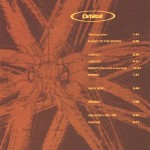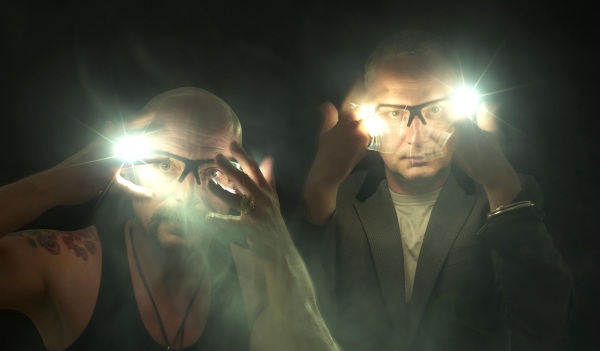In December 1989, a pair of brothers crafted a catchy dance tune that would foreshadow a career of brilliant arrangements, political statements, intricate live performances, forays into more experimental territories, and crown them among the gods of modern music. That song, “Chime”, has been worked and reworked a dozen times, and yet has never lost its charm. As it approaches its 25th birthday in December, and as their masterpiece Snivilisation turns 20 today, it seems an appropriate time to take a brief look into the history of one of electronica’s most massively influential acts, Orbital.

Orbital’s debut set them aside from the dance producers of the time with hits like “Chime”, “Belfast”, and “Satan”.
Paul and Phil Hartnoll, the masterminds behind Orbital, released their eponymous debut in 1991, often referred to as The Green Album. Opening with a Star Trek quote and the simple clicks and beeps of “The Moebius”, it unraveled several glowing tracks of irresistible hooks, four-on-the-floor big beats, occasional samples, and warm synths. There were several differences in the tracklisting between countries and between release formats. With several great singles, including “Belfast”, “Satan”, and their famous “Chime”, in which bouncing synths echoed among a throbbing acid bass line, the album quickly flagged them as one of the names to watch in the rising house music scene.
It was followed by a second self titled album, sometimes called Orbital II or The Brown Album. The first track, “Time Becomes”, was meant as a cheap joke. A looped sample taken from the beginning of the first album, the brothers hoped to trick listeners into thinking that they had purchased a defective copy of The Green Album. However, as the loop began to go in and out of sync with itself, the move revealed itself as intentional, though it remained disorienting. To persist in the “defective record” joke, the beginning of the next track was mixed through the stereo channels improperly and covered in static. Finally, though, Orbital let go of the act and a pulsing sound took front and center. Soon, drums, frenzied sound effects, and repetitive samples led the listener into a memorable throng of sound. The other tracks followed suit with the formula – build up, adding layer upon layer. The melodies and sounds melted together beautifully. “Lush 3-1” became another hit, “Monday” generated a sense of euphoria, and “Halcyon+On+On” proved that Orbital had more up their sleeves than the simple dance music of the time.

Snivilisation, with a serene cover, signaled a movement towards a more detailed, ambient type of house music. It doubled as a political statement.
Expectations of Orbital were growing, and yet in 1994, they did not disappoint, when they released Snivilisation. The album, whose 20th anniversary is today, was somewhat of a deviation from their previous work, focusing less on House and more on the rising “intelligent techno movement” that was guiding electronic more towards a listening based experience than a dancing one. (See my article on the Artificial Intelligence Series). The opening track was more ambient and even followed somewhat of a verse-chorus structure, and yet became one of Orbital’s best tracks. It was washed away by the sound of rain, distorted into a muffled bubbling sound that acted as a backdrop to subtle synth melodies and a ring leader advertising his freak show. Later, Orbital traveled back into more forward dance tracks like “Crash and Carry”, that was just noisy enough to elicit a personal rave. More melodic tracks ensued, including “Science Friction”. “Kein Trink Wasser” harked back to Orbital II days, building layers of sound that slowly increased in complexity. Though they had moved more away from the dance music of their youth, “Are We Here?” took a dramatic shift towards Jungle/Drum ‘N’ Bass music, with shuffling rhythms, chopped samples, and a changing melody throughout. The track even acted as a political statement, to protest the anti-rave laws by the British legislature, boldly asking “What does God say?” The album closed with “Attached”, a beautiful work of layering that left listeners eager to hear more from the hypnotizing duo. Snivilisation made it to number 4 on the charts and was included in the book 1001 Albums You Must Hear Before You Die.

Considered by many to be their greatest work, In Sides is a dark, complex album that explores the themes of environmental destruction. A bonus disc shows off their live skill, which they were well known for.
With all eyes on them, Orbital progressed further with In Sides, their most detailed and melodically complex release yet. Spending 12 weeks at number 5 on the charts and being certified gold, In Sides is considered by many to be Orbital’s magnum opus. The album, themed around environmental issues, opened with “The Girl With The Sun In Her Head”, which was recorded entirely in a Greenpeace bus using solar power. With several layers of intricate harmonies working together, the song gave hint at the awe-inspiring beauty the album would present. It was followed with the punishing “P.E.T.R.O.L.”, a harsher track meant as equally for headphones as for raves. “The Box”, whose single charted at number 11, became one of Orbital’s most well known tracks, a dark song overlaid by deceptively playful bells. The album was telling a story, and it only became darker as it played on. “Dwr Budr”, Welsh for “dirty water”, hissed as synths faded in and out. Alison Goldfrapp was featured on the track, chanting nonsensically as the sinister melodies formed around her. Afterwards, “Adnan’s” presented Orbital’s more introspective side, with a downtempo beat that was a little too slow for strobe lights. The album closed with a 23 minute paranoid track lamenting an extraterrestrial invasion.
In 1997, the album was released with a bonus disc that included live performances by the band and their written theme for the film The Saint. The live aspect of Orbital was crucial to their success. Up until Orbital, electronic music’s live performances consisted mainly of DJ

The Middle of Nowhere was continued on the formula that made In Sides successful, crafting intricate dance hits with enough layers to reveal new sounds with each listen.
sets or prerecorded material. The Hartnolls, who were influenced mainly by punk rock, were well known for being able to make their music feel truly live. Elements of improvisation were included in the performances. “Halcyon (live)” even included clips from “You Give Love a Bad Name” and “Heaven is a Place on Earth”, which were incorporated seamlessly…and even backwards. In Sides gained overwhelming critical acclaim.

The Altogether was a double disc album that signalled a return to an older style with simpler melodies and catchy hooks. The cover features an X-Ray of the band members’ heads, including the headlights they were famous for in live shows.
The Middle of Nowhere, which charted at number 4, continued in a similar venue as In Sides, and tracks like “Know Where to Run” implied a sense of urgency, while “I Don’t Know You People” put madness in proper perspective. Its follow-up, The Altogether, while criticized as scatterbrained, turned over several spectacular tracks, including the catchy “Oi”, the familiar “Doctor?” (Orbital’s take on the Doctor Who theme), “Illuminate”, a pleasant dance track featuring David Gray, “Beelzebeat”, and alternate versions of several tracks from The Middle of Nowhere. Orbital released Blue Album (Actually given that title, perhaps as a tribute to the colloquial names given to the original self titled releases) in 2004 and announced their breakup.
In 2009, a greatest hits compilation called “Orbital 20” was released to celebrate 20 years

Blue Album was Orbital’s “farewell”, as they announced their breakup. It featured the familiar sketch of the atom, from which they derived their band name.
from the release of “Chime”, and with it Orbital announced a temporary reunion to tour. Shortly thereafter, the reunion became permanent and they released their most recent studio album, Wonky, in 2012. Wonky was largely a triumphant return, as good or better than Orbital’s last few releases before the breakup. “Straight Sun” harked back to Orbital’s infancy, while “Never” and “New France” proved their relevancy in modern dance music.

A triumphant return for one of house music’s most important acts, Wonky consisted of sometimes bizzare, sometimes catchy melodies in the layered method Orbital often uses.
“Beelzedub” showed up several of today’s dubstep artists, while “Wonky” managed to be both enjoyable and entertainingly absurd. “Where Is It Going?” closed the album, a nostalgic dance track whose title was ever so appropriate to the situation.
Orbital’s ability to marry rock structures to electronic music is perhaps their biggest contribution to both genres to date. Countless artists have taken their example and have used it to perform truly live, to cross house into other genres, to sample perfectly, and to find balance between the catchy and the clever, the detailed and the danceable. As EDM has taken wing in every aspect of music from indie to pop to jazz in the past few years, listeners from around the world should turn an ear to the dance geniuses that made house music what it is today. With Orbital back together and making music that remains light-years ahead of their competition in techno, we are all left wondering what’s next. Where is it going, Orbital?
Suggested Listening:







